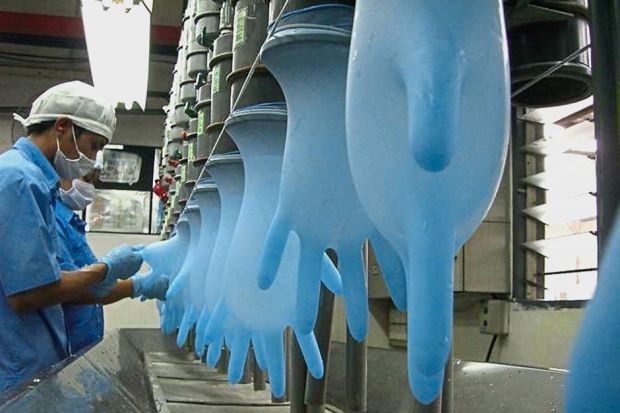NATURAL rubber remains an important contributor to our nation’s economy. The revenue earned from natural rubber products still runs into billions of ringgit and the industry continues to provide much-needed employment for both rural and urban folks.

Rubber smallholders still enjoy reasonable incomes even though their earnings are not as lucrative as in the 70s and 80s.
In the northern states of Kedah and Perlis where the longer-than- average dry conditions do not permit good yields from oil palm, rubber offers the best option. Manufacturing of rubber products, especially gloves (pic) in which Malaysia is still a world leader, is thriving. And with the healthy export of rubberwood furniture, one can appreciate the important role natural rubber still plays in the nation’s economy.
However, many would agree that natural rubber has lost much of its earlier bounce. Its resilience in fighting off competition is also weakening due to the onslaught of more innovative and competitive materials in the marketplace. Even in the glove trade where natural rubber used to dominate, much of its share is slowly being eroded by synthetics. Previous attempts to penetrate the synthetics market with modified natural rubber, such as epoxidised natural rubber, have also not shown much headway.
The lethargic price of the raw commodity is also a concern. The industry is slowly losing diehard rubber smallholders as a result.
The ageing demographic is also affecting natural rubber productivity in this country as young Malaysians shy away from tapping rubber and tending the trees.
How can we bring the bounce back to natural rubber? Can we
get any clue from the many mega-trends shaping the world economy?
The authors of the book No Ordinary Disruption: The Four Forces Breaking All the Trends have opined that the operating system of the world economy is being rewritten and that there are new trends reshaping the world.
According to them, we are now experiencing the coming together of four fundamental disruptive forces and they estimate this change is happening at roughly 3,000 times the impact of the past change.
Unfortunately, they claim, most among us still fail to appreciate their full magnitude. According to their analysis, these trends are gaining strength, magnitude and influence as they interact with and feed upon one another. Together, they are producing monumental change in the world.
What are these major trends? The first is the shift in the centre of economic activity to emerging markets like China at a speed never before witnessed. By 2025, China will be home to more large companies, those with revenues of US$1bil or more, than either the United States or Europe.
The second disruptive force is the accelerating economic impact of technology. It took more than 50 years for the telephone to penetrate half of American homes after its invention but Facebook attracted six million users in its first year.
Next, fertility is falling. About 60% of the world’s population now live in countries with fertility rates below the replacement rate. The number of people of working age will also fall. China’s labour force peaked in 2012. Caring for large numbers of elderly people will put pressure on government finances.
The final disruptive force is the growing world connectivity. Instead of only connecting major trading hubs in Europe and North America, the global trading system has expanded. Asia is becoming the world’s largest trading region. The volume of trade between China and Africa rose from US$9bil in 2000 to US$211bil in 2012. More than one billion people crossed borders in 2009, over five times the number in 1980. This is ushering in a new phase of globalisation, creating unmatched opportunities and unexpected volatility.
The fact that all four are happening at the same time means that our world is changing radically. All industries, including natural rubber, will have to wake up to the new reality. The industry needs new strategies if it is to capture the opportunities presented by the megatrends while effectively mana-ging the threats posed by the volatility and uncertainty in the market.
PROFESSOR DATUK DR AHMAD IBRAHIM
UCSI University



























